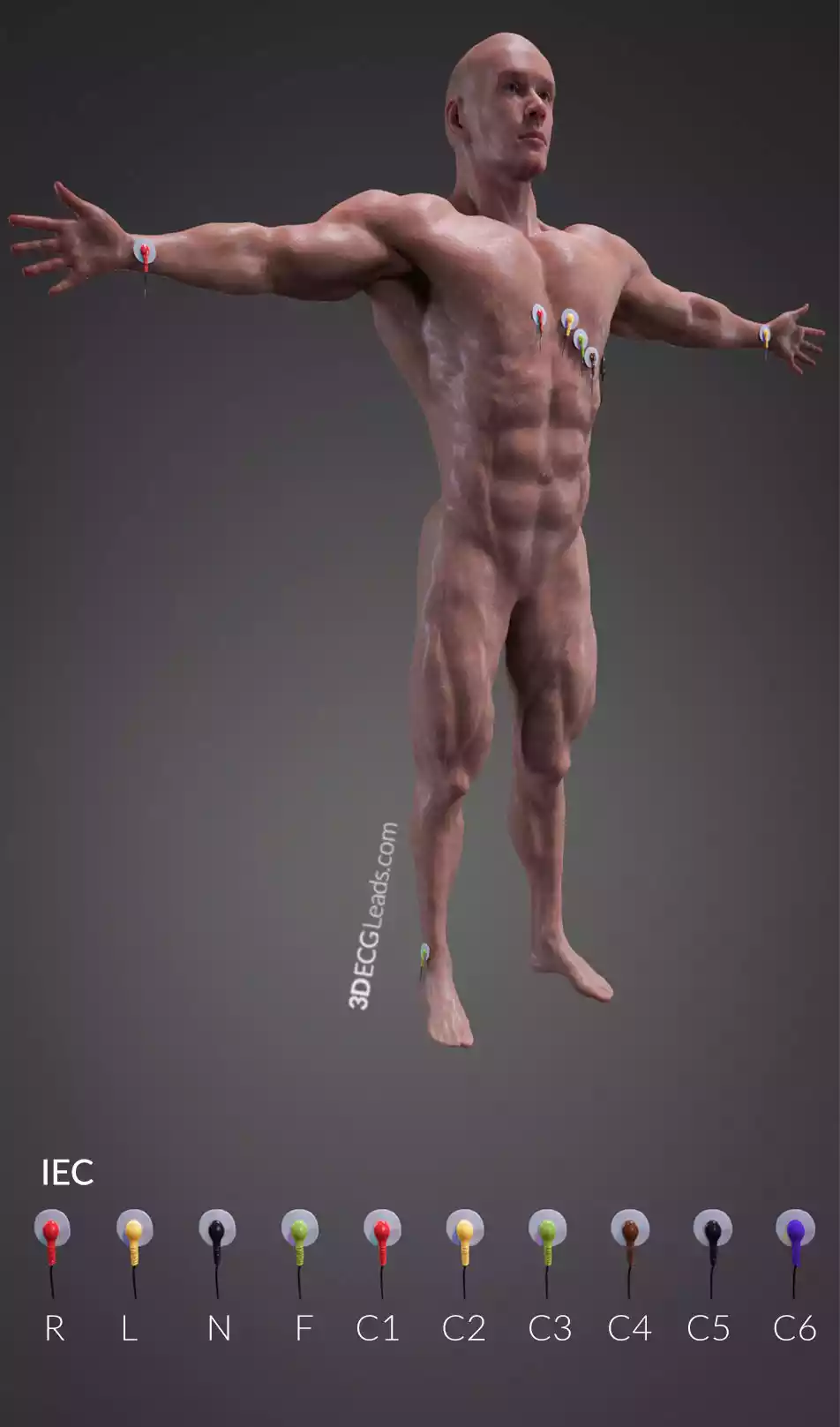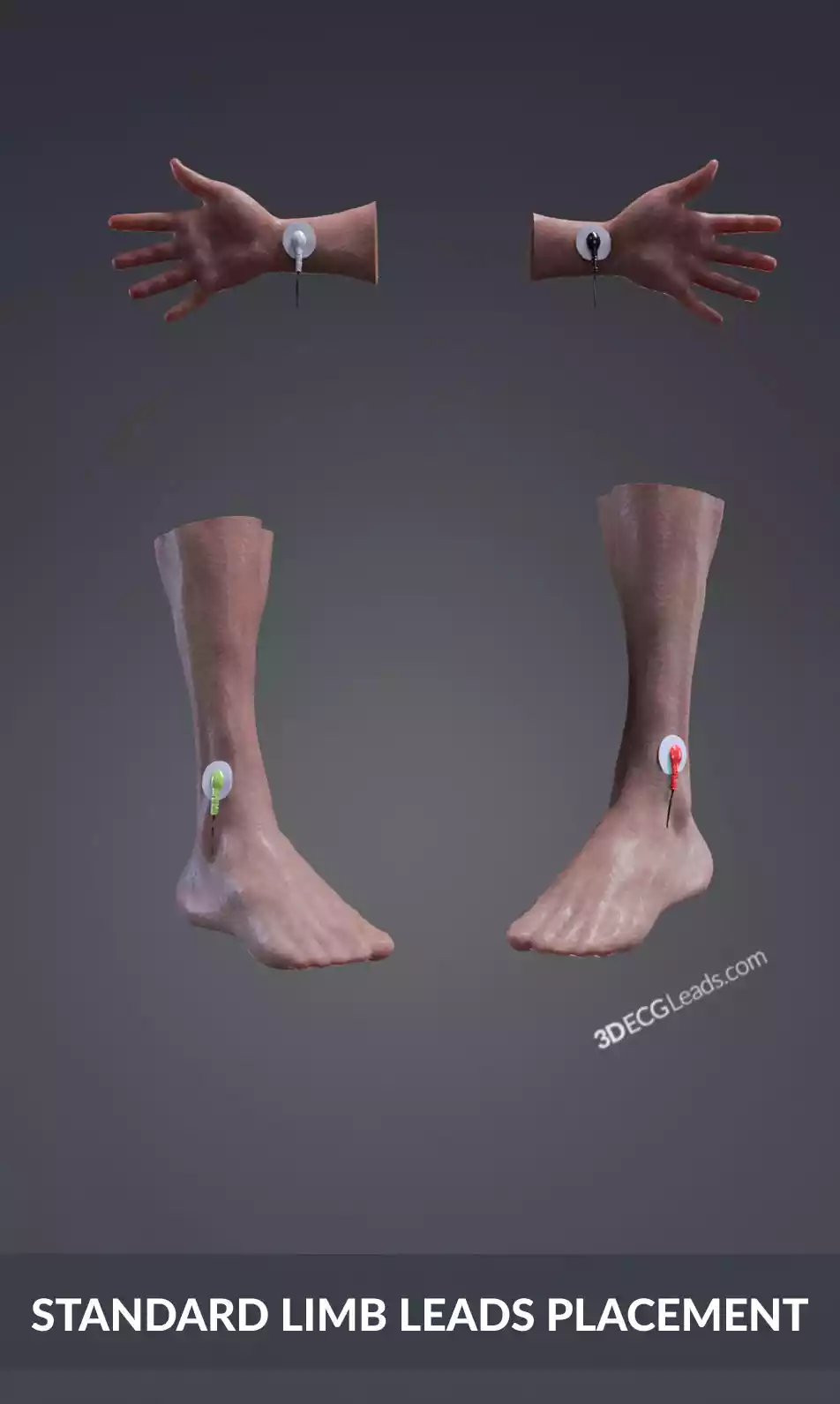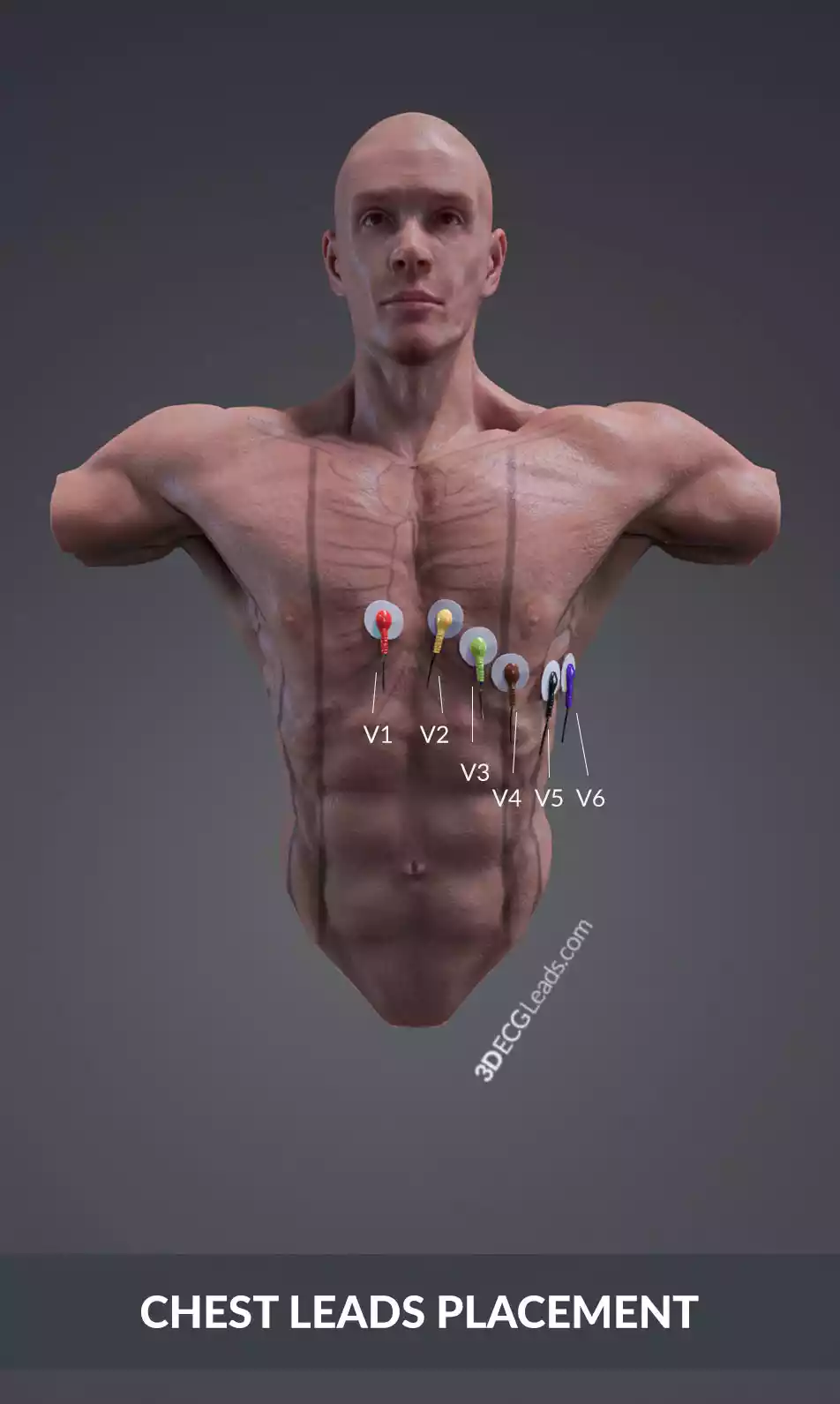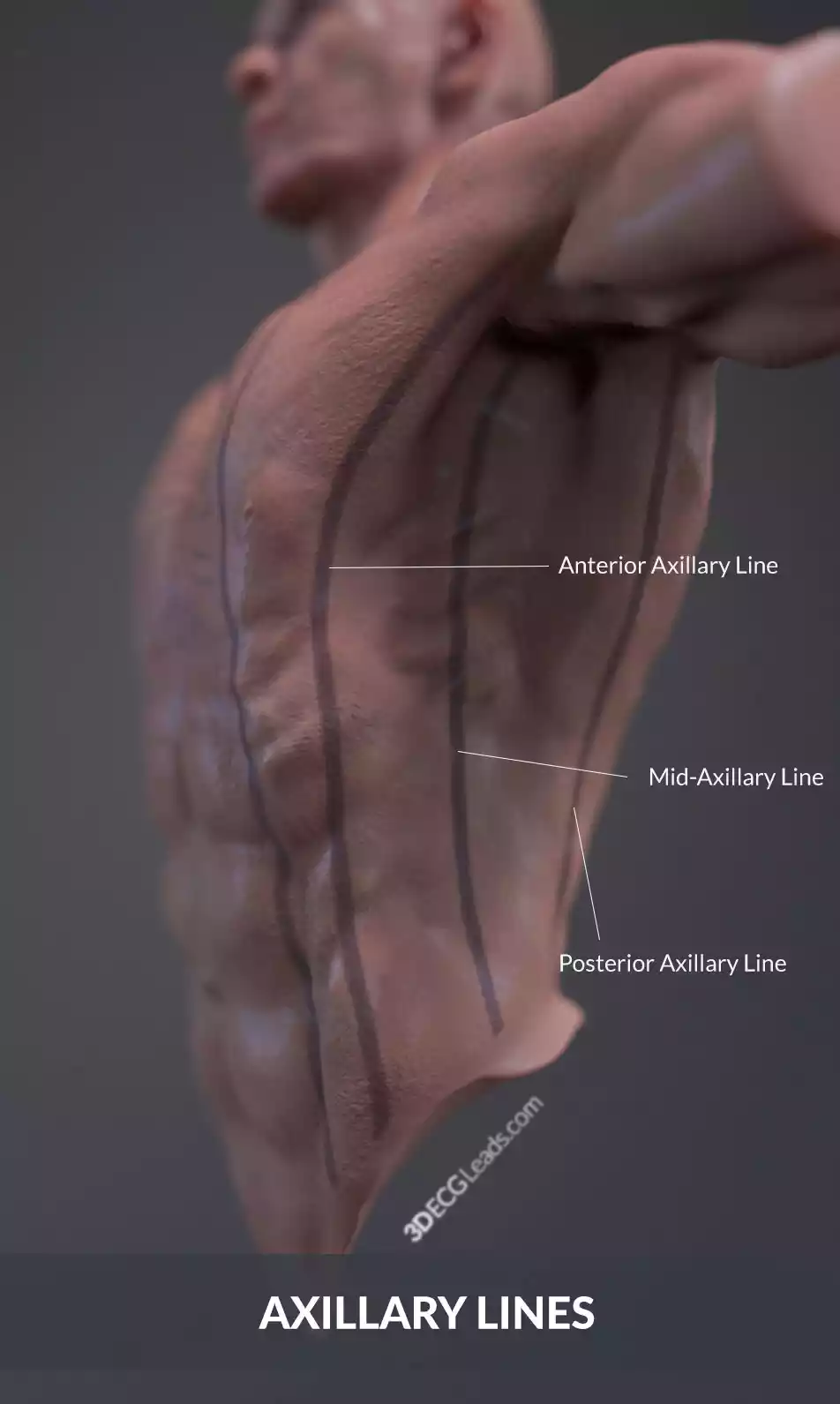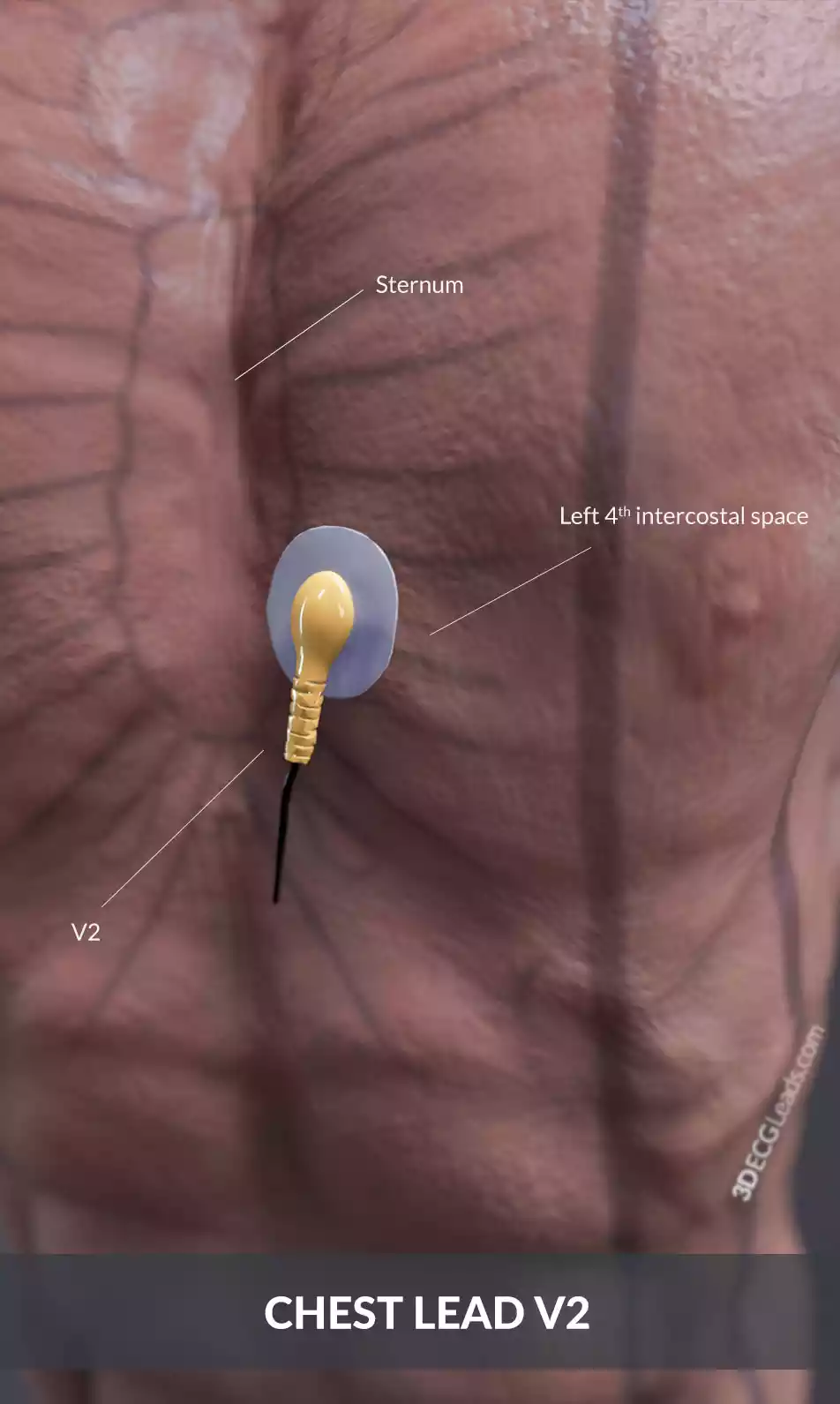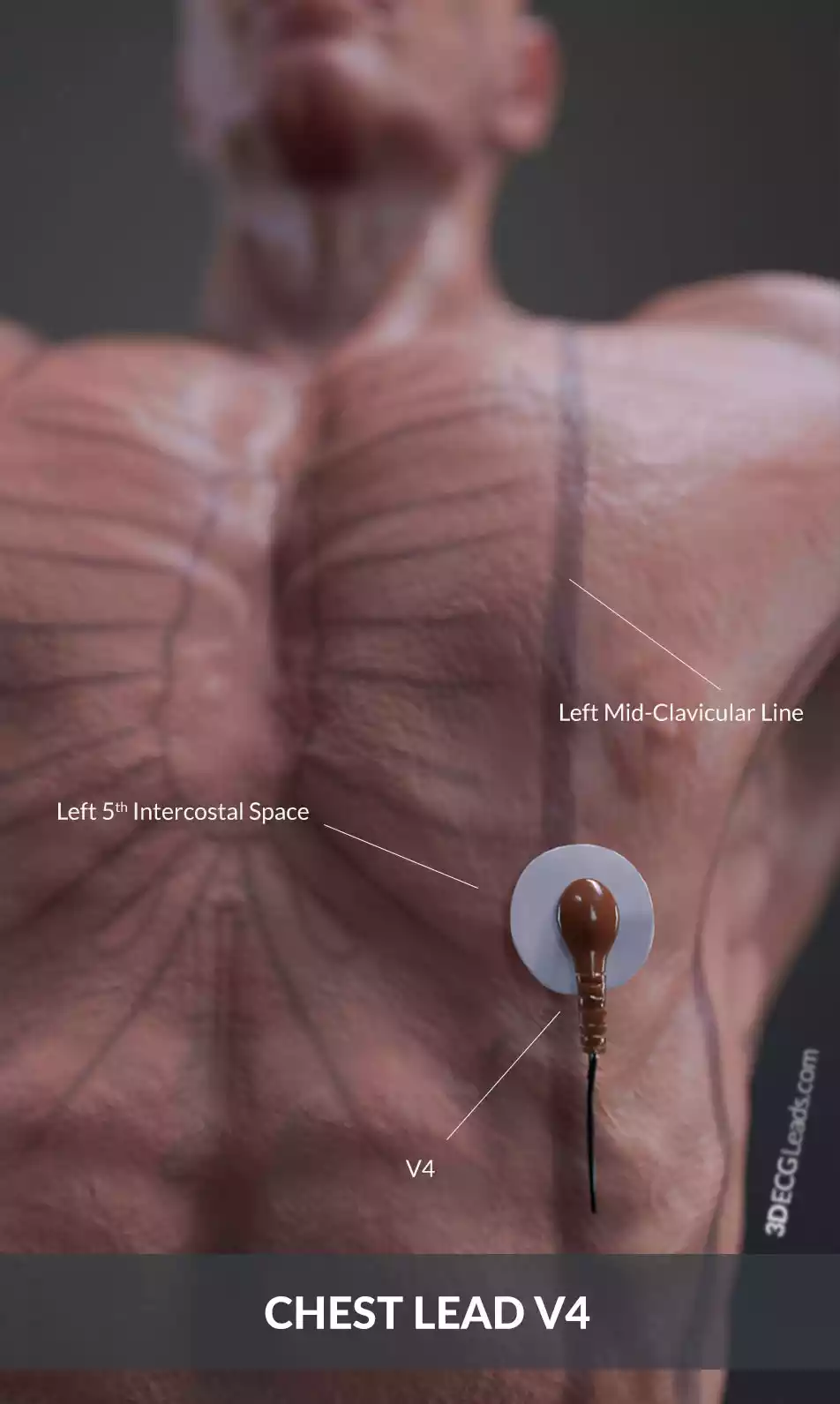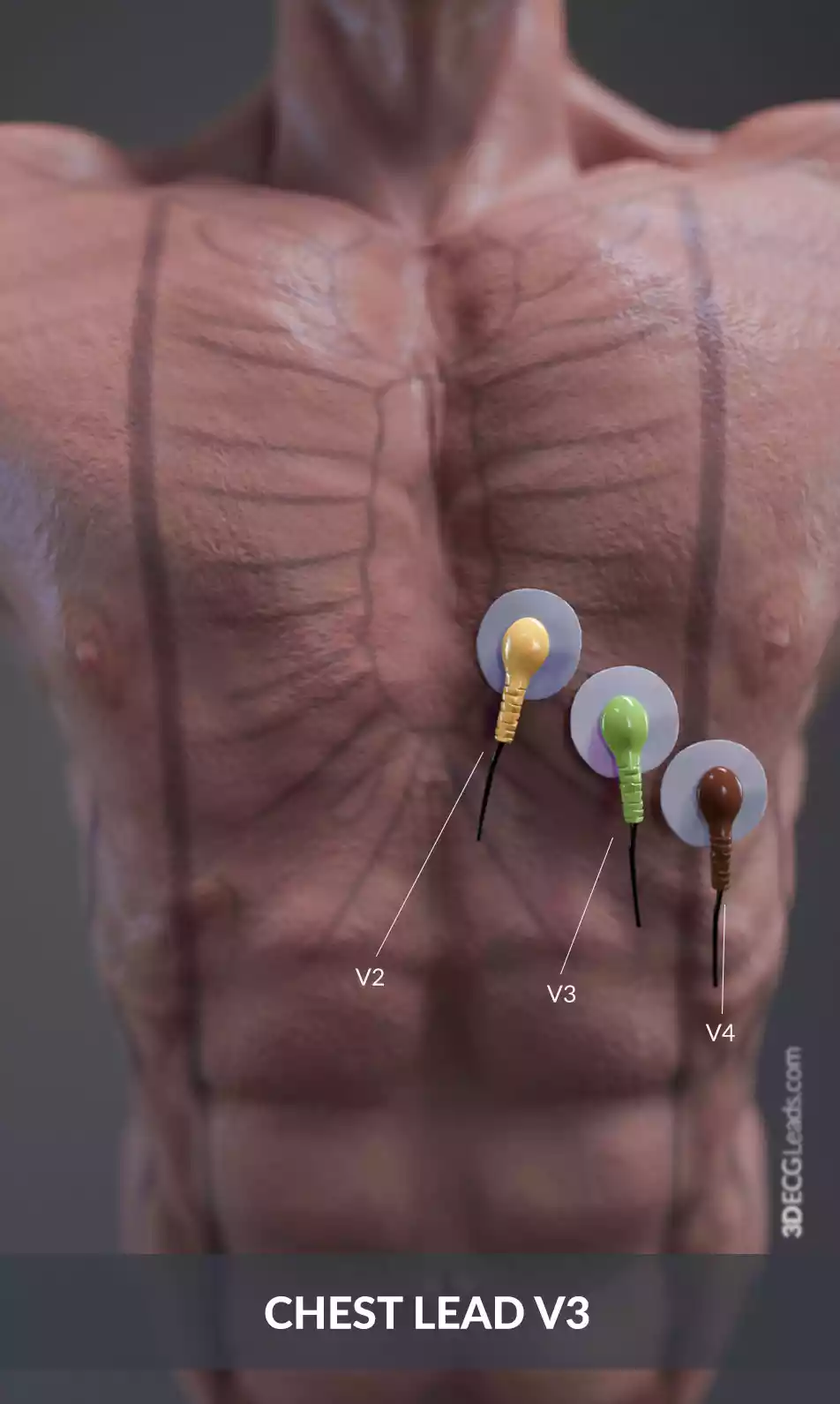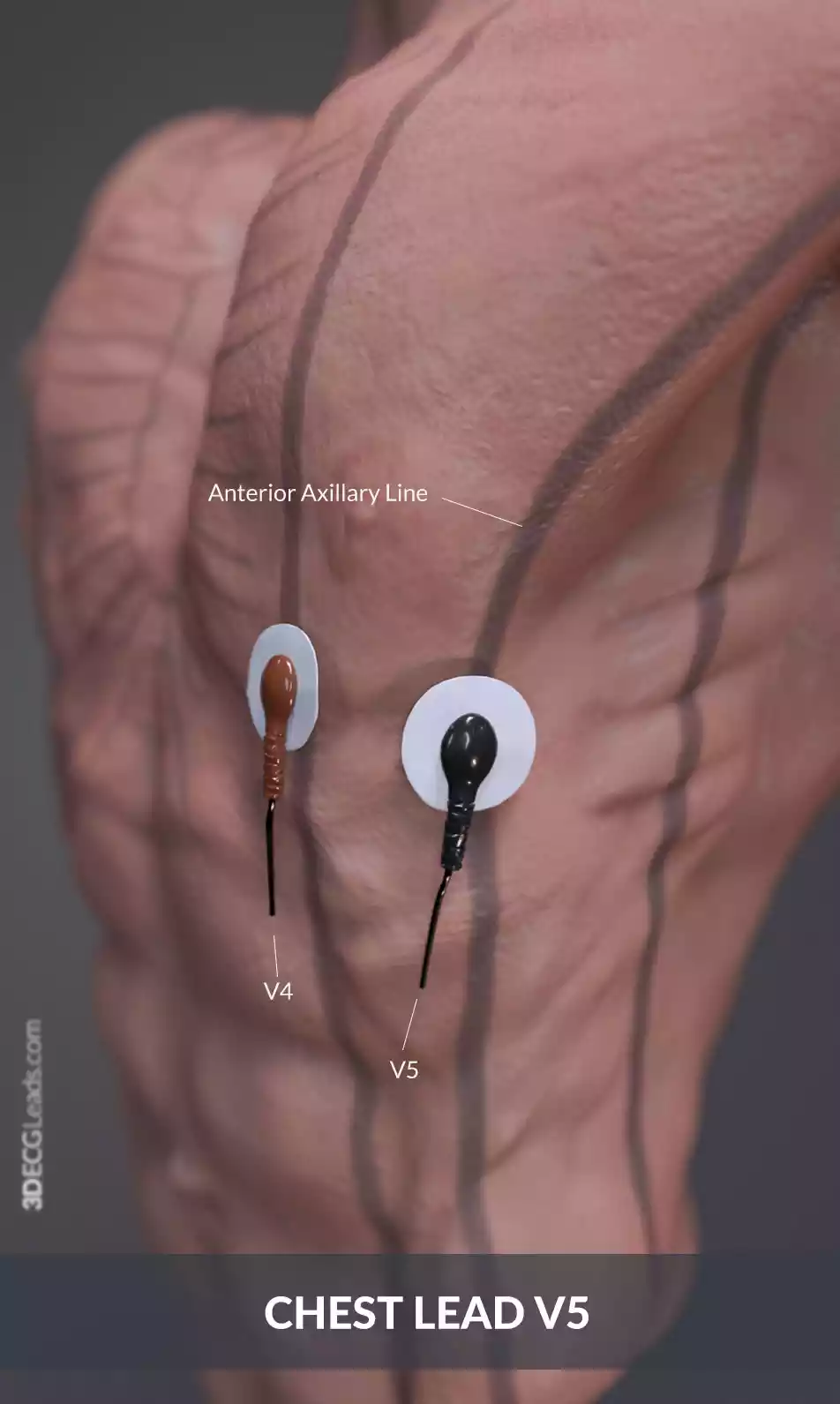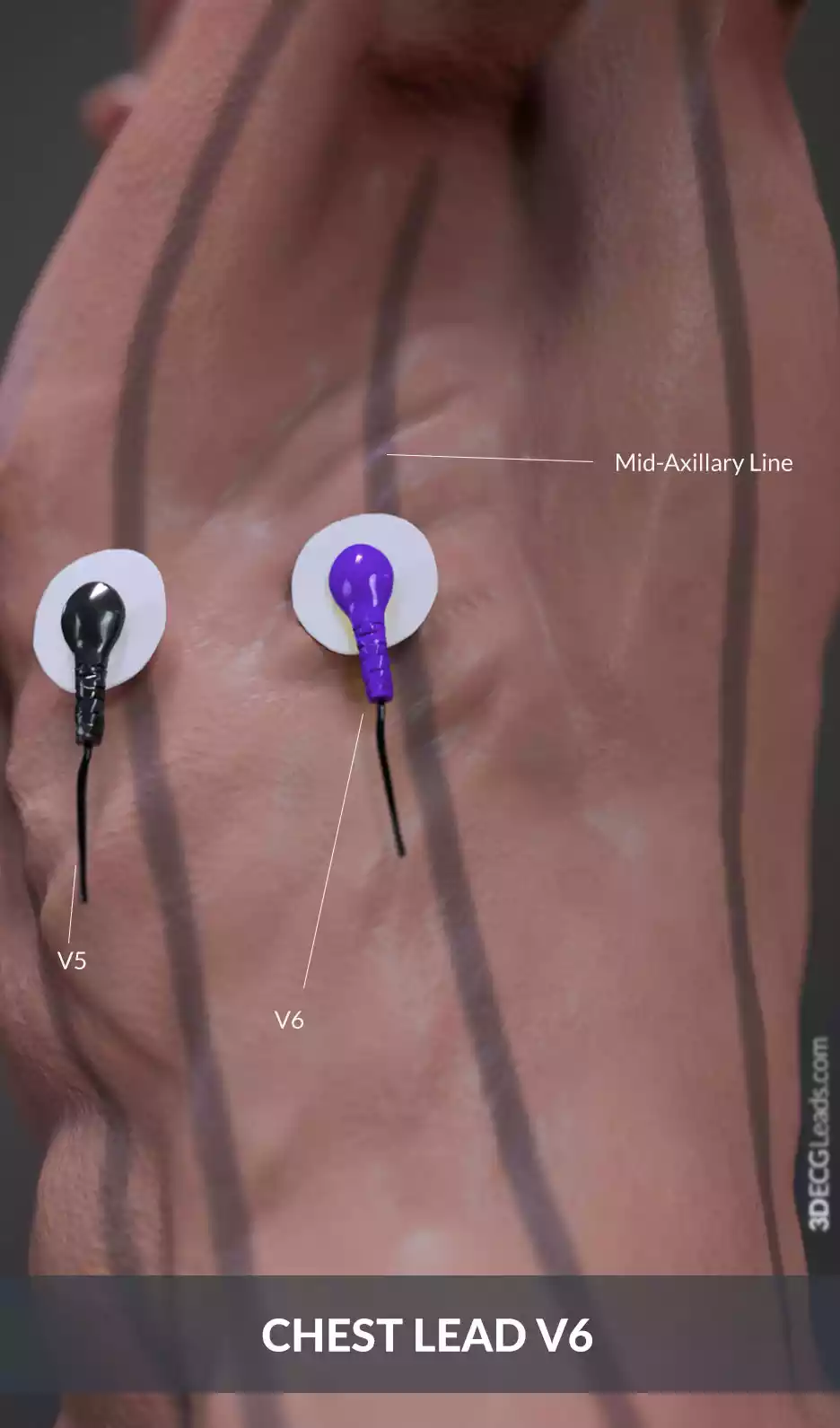12 LEAD ECG - CORRECT ECG LEAD PLACEMENT
HOW TO PLACE ECG LEADS
- ECG LEADS PLACEMENT OVERVIEW
- THE IMPORTANCE OF CORRECT ECG LEAD PLACEMENT
- ECG LEADS COLOR CODING SYSTEMS
- WHAT ARE THE ECG LEADS COLOR CODING SYSTEMS
- AHA – AMERICAN HEART ASSOCIATION
- IEC – INTERNATIONAL ELECTROTECHNICAL COMMISSION
- HOW TO PLACE THE ECG LIMB LEADS
- THE STANDARD ECG LIMB LEADS PLACEMENT
- THE MODIFIED ECG LIMB LEADS PLACEMENT
- RECOMMENDATION
- HOW TO PUT ECG LEADS ON CHEST ?
- WHERE TO PLACE ECG LEADS ON CHEST ?
- WHAT HAPPENS IF CHEST LEADS ARE MISPLACED ?
- HOW TO PLACE ECG LEADS ON CHEST ?
- CHEST ANATOMY FOR CHEST LEAD PLACEMENT
- CHEST LEAD PLACEMENT - V1
- CHEST LEAD PLACEMENT - V2
- CHEST LEAD PLACEMENT - V4
- CHEST LEAD PLACEMENT - V5
- CHEST LEAD PLACEMENT - V6
- REFERENCES
ECG LEADS PLACEMENT OVERVIEW
Using a correct standard ECG lead placement technique when performing a 12 lead ECG is crucial. The reason being that any misplacement of the ECG leads may lead to a misdiagnosis or further, unnecessary investigations and treatments. (Ilg & Lehmann, 2012; Harrigan, et al., 2012; Jowett, et al., 2005; Toosi & Sochanski, 2008; Lynch, 2014). The purpose of this short video and text, along with our app, is not aimed at replacing high-quality training but rather to demonstrate a more visual, interactive way of the standard lead placement technique. Additionally, it highlights a few vital reasons why this ECG lead placement technique has to be taken seriously. All medical personnel who are operating a 12 lead ECG machine should have proper training of ECG lead placement (Kligfield, et al., 2007; Crawford & Doherty, 2010)
THE IMPORTANCE OF CORRECT ECG LEAD PLACEMENT
The incorrect ECG lead placement is a well-known and common problem. Just a few misplaced ECG leads can record an ECG tracing that might mimic other ECG tracings seen in some pathologies. It will also affect the quality of the ECG waves that are recorded by the 12 lead ECG machine, eventually leading to a misdiagnosis (Medani, et al., 2018; Garcia, 2015; Harrigan, et al., 2012). Out of all these pathologies, the false diagnosis of Acute Myocardial Infarction is very concerning (Lynch, 2014; Toosi & Sochanski, 2008). One of the most common ECG lead misplacements is the Upper Limb Lead reversal; a reversal that can markedly alter the final ECG tracing (Harrigan, et al., 2012). This can be avoided due to the ECG leads color coding systems Figure 1.
ECG LEADS COLOR CODING SYSTEMS
WHAT ARE THE ECG LEADS COLOR CODING SYSTEMS
The ECG leads appear in different standard colors, Figure 1.The purpose of these colors is to speed up the process and avoid limb leads reversal (Crawford & Doherty, 2010). There are two main ECG leads color coding systems: An American system, also known as the American Heart Association ( AHA ), Figure 2, and a European one, known as the International Electrotechnical Commission ( IEC ) (Crawford & Doherty, 2009), Figure 3. In these systems, each ECG lead has a different color as well as a different ID. The leads color and ID’s vary from one system to another, but sometimes the ID of one system can be labelled on the other one (Crawford & Doherty, 2009). Due to the ECG Leads Color System’s variation, it is recommended to check the ECG machine’s color coding before performing any 12 lead ECG (Crawford & Doherty, 2009).
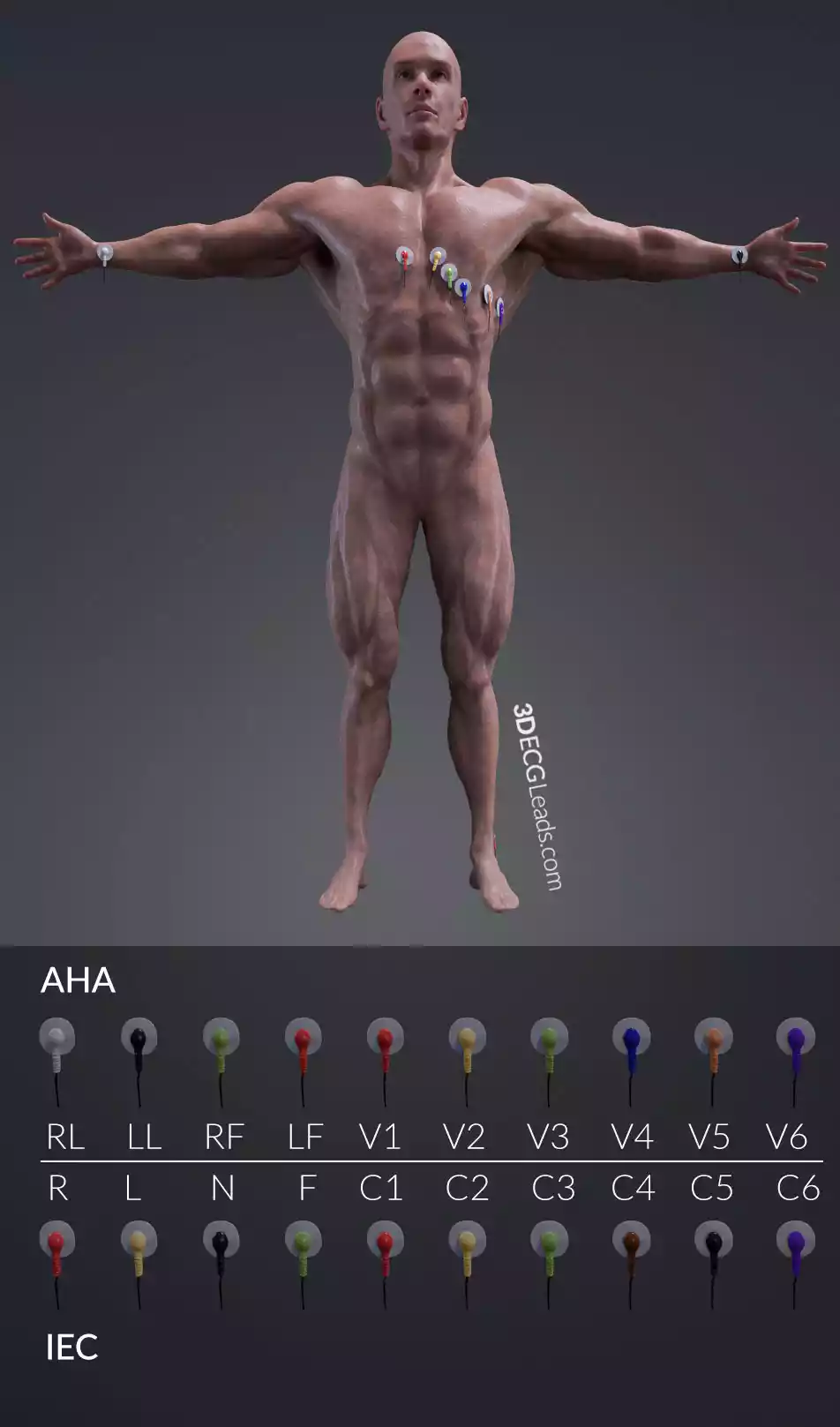
Figure 1 10 lead ECG placement color coded. The purpose of these colors is to speed up the process and avoid limb leads reversal.
AHA – AMERICAN HEART ASSOCIATION
This system most often has the ID’s and colors as follows: see Figure 2, (Crawford & Doherty, 2010; Crawford & Doherty, 2009):
- Right Arm Lead: ID – RA, Color White;
- Left Arm Lead: ID -LA, Color Black;
- Right Leg Lead: ID-RL, Color Green;
- Left Leg Lead: ID- LL, Color Red;
- First Chest Lead: ID – V1, Color Red;
- Second Chest Lead: ID-V2, Color Yellow;
- Third Chest Lead: ID-V3, Color Green;
- Forth Chest Lead: ID-V4, Color Blue;
- Fifth Chest Lead: ID-V5, Color Orange;
- Sixth Chest Lead: ID-V6, Color Purple;
IEC – INTERNATIONAL ELECTROTECHNICAL COMMISSION
The leads in this system most often have the ID’s and colors as follows: see Figure 3, (Crawford & Doherty, 2010; Crawford & Doherty, 2009):
- Right Arm Lead: ID - R, Color Red;
- Left Arm Lead: ID - L, Color Yellow;
- Right Leg Lead: ID- N, Color Black;
- Left Leg Lead: ID - F, Color Green;
- First Chest Lead: ID - C1, Color Red;
- Second Chest Lead: ID - C2, Color Yellow;
- Third Chest Lead: ID - C3, Color Green;
- Forth Chest Lead: ID - C4, Color Brown;
- Fifth Chest Lead: ID - C5, Color Black;
- Sixth Chest Lead: ID - C6, Color Purple;
HOW TO PLACE THE ECG LIMB LEADS
THE STANDARD ECG LIMB LEADS PLACEMENT
The standard positioning of the ECG limb leads is in the position of the wrist and ankles, Figure 4, and is recommended to be used whenever possible (Menzies-Gow, 2018; Campbell , et al., 2017). In some cases, it is not always possible to place the ECG limb leads on the ankles or the wrists, as in the case of an amputated limb, for example. In such cases, the ECG limb lead can be placed above the amputated limb (Crawford & Doherty, 2012), but if done so the ECG limb leads should be at an equal distance bilaterally (Garcia, 2015).
THE POSITIONING OF THE ECG LIMB LEADS
- Right Arm Limb Lead RA (R) - is placed just above the right wrist (if possible).
- Left Arm Limb Lead LA (L) - is placed just above the left wrist (if possible).
- Right Leg Limb Lead RL (N) - is placed just above the right ankle (if possible).
- Left Leg Limb Lead LL (F) - is placed just above the left ankle (if possible).(Campbell , et al., 2017; Eldrige , et al., 2014).
THE MODIFIED ECG LIMB LEADS PLACEMENT
In certain emergency cases, it can be difficult to place the ECG limb leads on the limbs. Because of this dilemma, Takuma, et al. (1995) suggested an alternative ECG limb leads placement technique. This modified ECG leads placement system suggests that the ECG limb leads could be placed on the left and the right Acromial region for the upper limb leads, and on the left and right Anterior Superior Iliac Spine for the inferior limb leads. See Figure 5. The benefit of this modified ECG limb leads placement technique is that it is much faster and easier to be performed when compared to the standard one. It also reduces the muscular artefacts that are recorded with the standard ECG lead placement technique (Takuma, et al., 1995; Jowett, et al., 2005). This modified ECG lead placement system comes at a cost as it interferes badly with the way Einthoven’s Triangle is generated (Toosi & Sochanski, 2008), Figure 6. In other words, if the ECG limb leads are placed on the torso as pictured in Figure 5, the ECG waves that are recorded on the standard 12 lead ECG tracing will have some misleading differences and, therefore, may lead misdiagnosis. (Toosi & Sochanski, 2008; Jowett, et al., 2005).
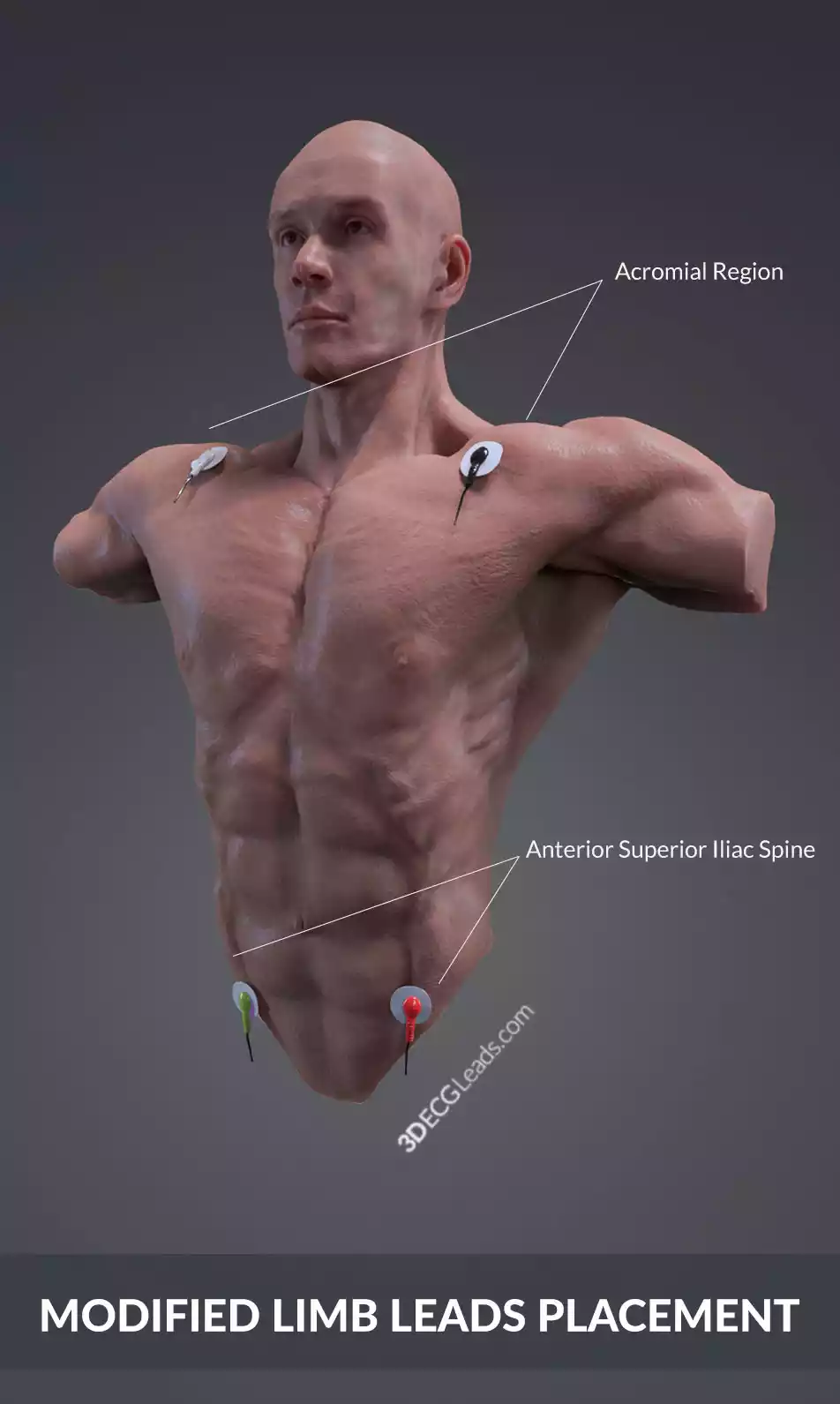
Figure 5 The Modified limb leads placement. In the modified limb leads placement, the Upper Limb Leads are placed on the Acromial Region and the Lower Limb Leads are placed in the Anterior Iliac Spine region
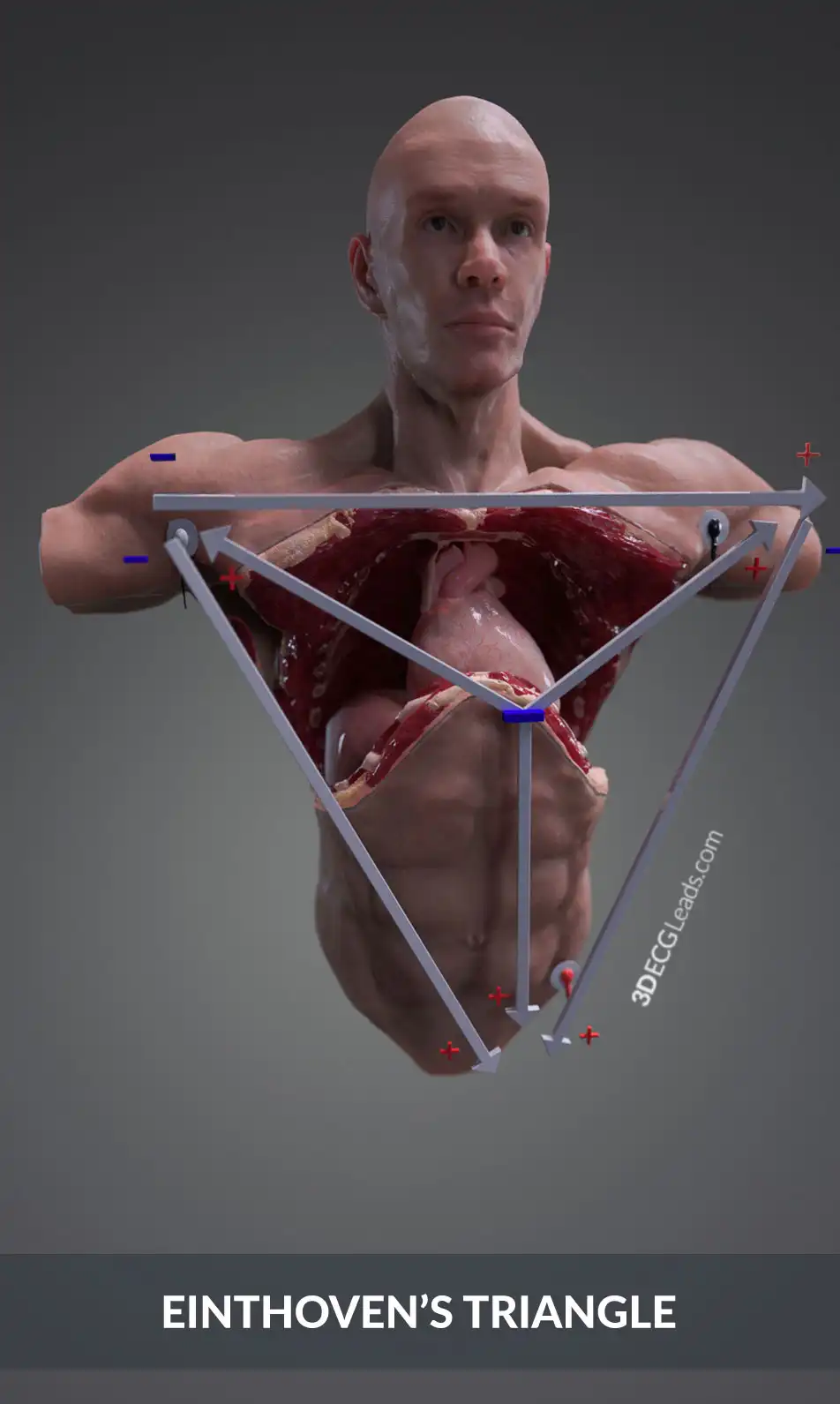
Figure 6 Einthoven Triangle. For an interactive visualization of Einthoven Triangle, check our app
RECOMMENDATION
To avoid any misdiagnosis, it is recommended to use the standard ECG lead placement system whenever possible, Figure 4 (Campbell , et al., 2017), especially if an Acute Myocardial Infarction is suspected (Toosi & Sochanski, 2008). If it is not possible to use the standard system and a modified ECG lead placement system is used, it is recommended to document this infromation on the 12 lead ECG tracing (Toosi & Sochanski, 2008). Sometimes in clinical practice, the 12 lead ECG tracing is repeated after a specific period of time. Most of the time, this new ECG tracing will be compared with the previous ECG tracing to see if any new changes appear. If one of the 12 Lead ECG tracings is recorded with the standard ECG limb lead placement system, Figure 4, and the second one with the modified ECG limb lead placement system, Figure 5, , differences between the two ECG tracings will occur which are not related to any underlying disease. In some cases these changes might lead to misdiagnosis. Therefore, it is recommended that the ECG tracing is to be labeled every time the modified ECG limb leads system, Figure 5, is used (Kligfield, et al., 2007; Eldrige , et al., 2014).
HOW TO PUT ECG LEADS ON CHEST
WHERE TO PLACE ECG LEADS ON CHEST
The chest leads are placed correctly as follows (Crawford & Doherty, 2010; Eldrige , et al., 2014), Figure 7:
- Chest Lead V1/C1 - Is the first ECG chest lead to be attached, and it has to be placed in the 4th Intercostal Space on the Right Border of the Sternum.
- Chest Lead V2/C2 - Is the second ECG chest lead to be attached, and it has to be placed in the 4th Intercostal Space on the Left Border of the Sternum.
- Chest Lead V4/C4 - Is the third ECG chest lead to be attached, and it has to be placed in the 5th Intercostal Space on the Mid-Clavicular Line.
- Chest Lead V3/C3 - Is the fourth ECG chest lead to be attached, and it has to be placed midway between V2/C2 and V4/C4.
- Chest Lead V5/C5 - Is the fifth ECG chest lead to be attached, and it has to be placed on the Anterior Axillary Line at the same level with V4/C4.
- Chest Lead V6/C6 - Is the sixth ECG chest lead to be attached, and it has to be placed on the Mid-Axillary line at the same level with V5/C5 and V4/C4.
WHAT HAPPENS IF CHEST LEADS ARE MISPLACED ?
Medani, et al. (2018) showed in their study that only in 34% of cases the ECG chest leads were placed correctly. When it comes to the ECG chest leads placement, the most common misplaced leads are: chest lead V1 and chest lead V2, along with chest lead V5 and chest lead V6, (Rajaganeshan, et al., 2007; Medani, et al., 2018). When performing a 12 lead ECG and a proper ECG lead placement technique is not used or ignored for any reason, there is an increased risk of misplacing the ECG leads. By misplacing the ECG chest leads, the 12 lead ECG tracing might be misleading, and in some cases, it might falsely show an Acute Myocardial Infarction (Ilg & Lehmann, 2012; Harrigan, et al., 2012). Therefore, any ECG lead misplacement should be avoided at all costs.
HOW TO PLACE ECG LEADS ON CHEST ?
The easiest way of misplacing the first and second ECG chest leads is by guessing the approximate location of the 4th Intercostal Space. Anyone who is locating the 4th Intercostal Space simply by looking at the skin is greatly contributing to higher chances of a misdiagnosis. To avoid any misplacements of the leads, a standard ECG chest leads placement technique has been developed, which is a technique that uses anatomical landmarks (Crawford & Doherty, 2010). This technique requires a basic knowledge of the thoracic anatomy: the location of the Sternum, the Sternal Jugular Notch, the Sternal Angle of Lewis, the Clavicle and the Intercostal Spaces, see Figure 8 (Crawford & Doherty, 2010). In some patients, the palpation of the Intercostal Spaces can be difficult, but the Jugular Notch of the Sternum is easy to palpate in most patients. The Jugular Notch taken as a landmark along with a specific technique can give us an accurate estimation of where the 4th Intercostal Space is located (Day, et al., 2015). Therefore, if an accurate ECG chest leads placement is wanted, these chest anatomical landmarks should be used (Campbell , et al., 2017; Kligfield, et al., 2007).
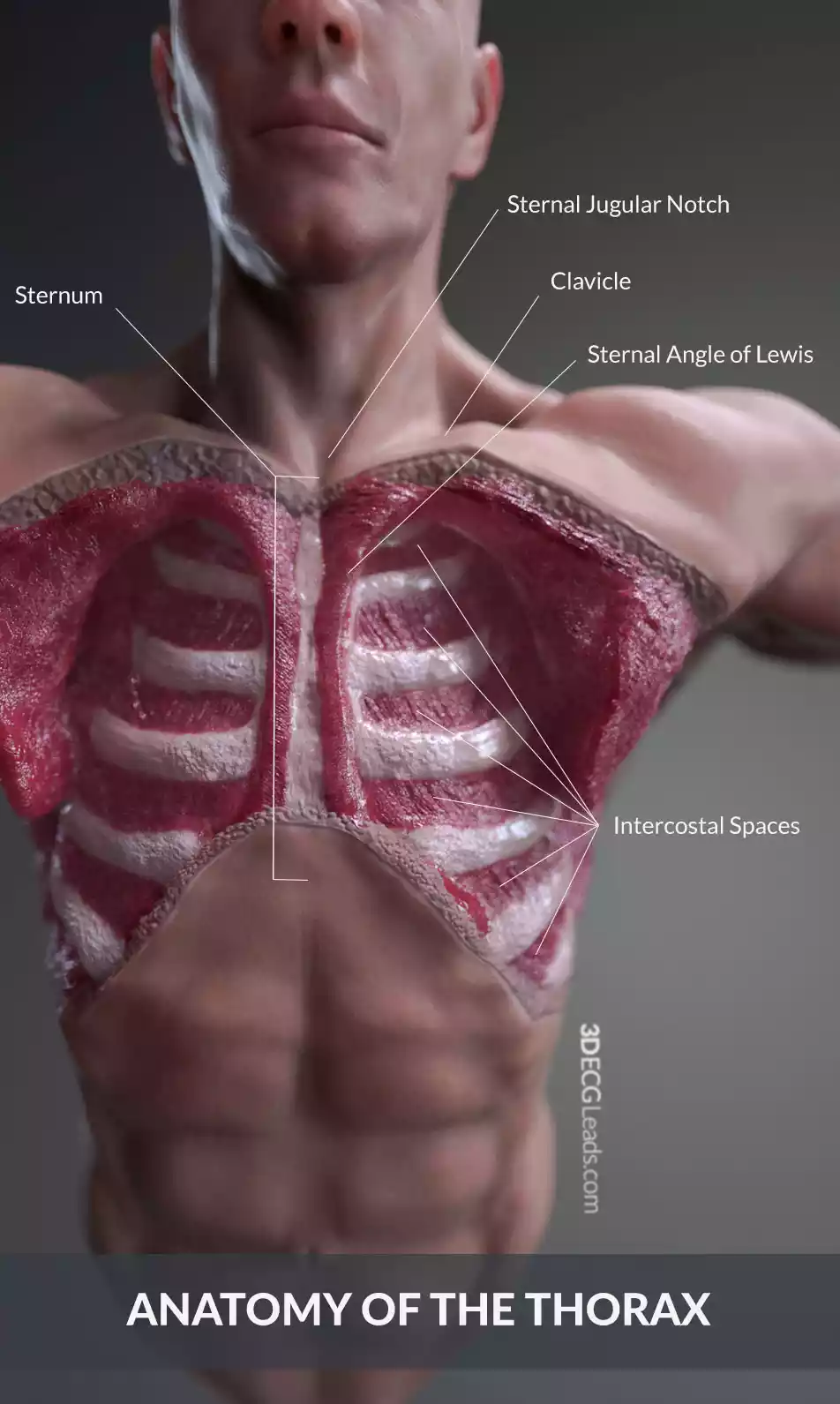
Figure 8 Chest Leads Placement requires a basic knowledge of the thoracic anatomy: the location of the Sternum, Sternal Jugular Notch, Sternal Angle of Lewis, Clavicle and Intercostal Spaces.
CHEST ANATOMY FOR CHEST LEAD PLACEMENT
For a better understanding of where all these landmarks are located, let’s review the basic anatomy of the chest.
The Sternum also known as the breastbone, Figure 9, has a notch at its top, named the Jugular Notch of the Sternum. The Jugular Notch can be palpated easily even in obese patients (Day, et al., 2015). The Jugular Notch can be palpated at the base of the neck Figure 8, and it is felt as a depression.
The Intercostal Spaces are the spaces that are located between the ribs as shown in Figure 8 and they usually have the same number as the Superior Rib. Ex Intercostal Space C2 is below Rib 2. The second rib articulates with the sternum right next to the Sternal Angle of Lewis (a ridge that can be palpated really easy on the upper third of the sternum), see Figure 9.
The Mid-Clavicular Line Figure 10, is the vertical line parallel to the long axis of the body that passes through the middle of the clavicle.
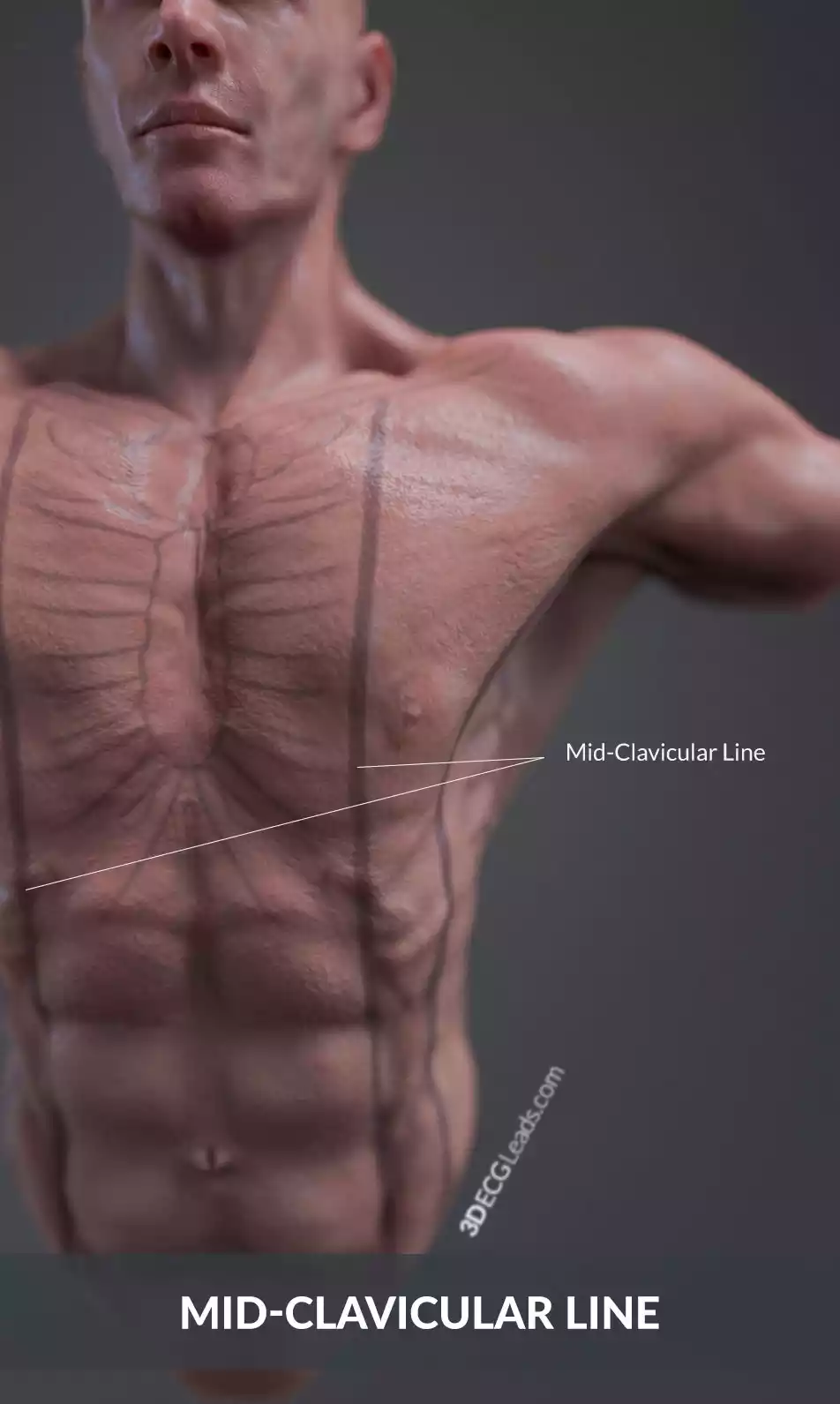
Figure 10 The Mid-Clavicular Line is the vertical line parallel to the long axis of the body that passes through the middle of the clavicle.
The Anterior Axillary Line, Figure 11, is the vertical line that goes through the anterior boundary of the Axilla (armpit), also known as the Anterior Axillary Fold. The Anterior Axillary Fold is formed by the Pectoralis Major Muscle.
The Mid-Axillary Line, Figure 11, is the line that goes through the center of the Axilla and is situated midway between the Anterior Axillary Line and the Posterior Axillary Line. The Posterior Axillary Line is the vertical line that passes through the posterior fold of the Axilla. The posterior fold of the Axilla is formed by the Latissimus Dorsi Muscle.
CHEST LEAD PLACEMENT - V1
The 1st ECG chest lead to be attached is V1(C1). It should be placed in the 4th Intercostal Space on the Right Border of the Sternum (Eldrige , et al., 2014), Figure 12.
- Step 1
- Palpate the Jugular Notch.
- Step 2
- Slide your fingers down until you feel a ridge (the Sternal Angle of Louis).
- Step 3
- Move your hand to your left and descend into the 2nd Right Intercostal Space.
- Step 4
- Move your hand down one rib to the 3rd Right Intercostal Space.
- Step 5
- Move your hand down one more rib to the 4th Right Intercostal Space.
- Step 6
- Place ECG Chest Lead V1(C1) in the 4th Right Intercostal Space on the Right Border of the Sternum.
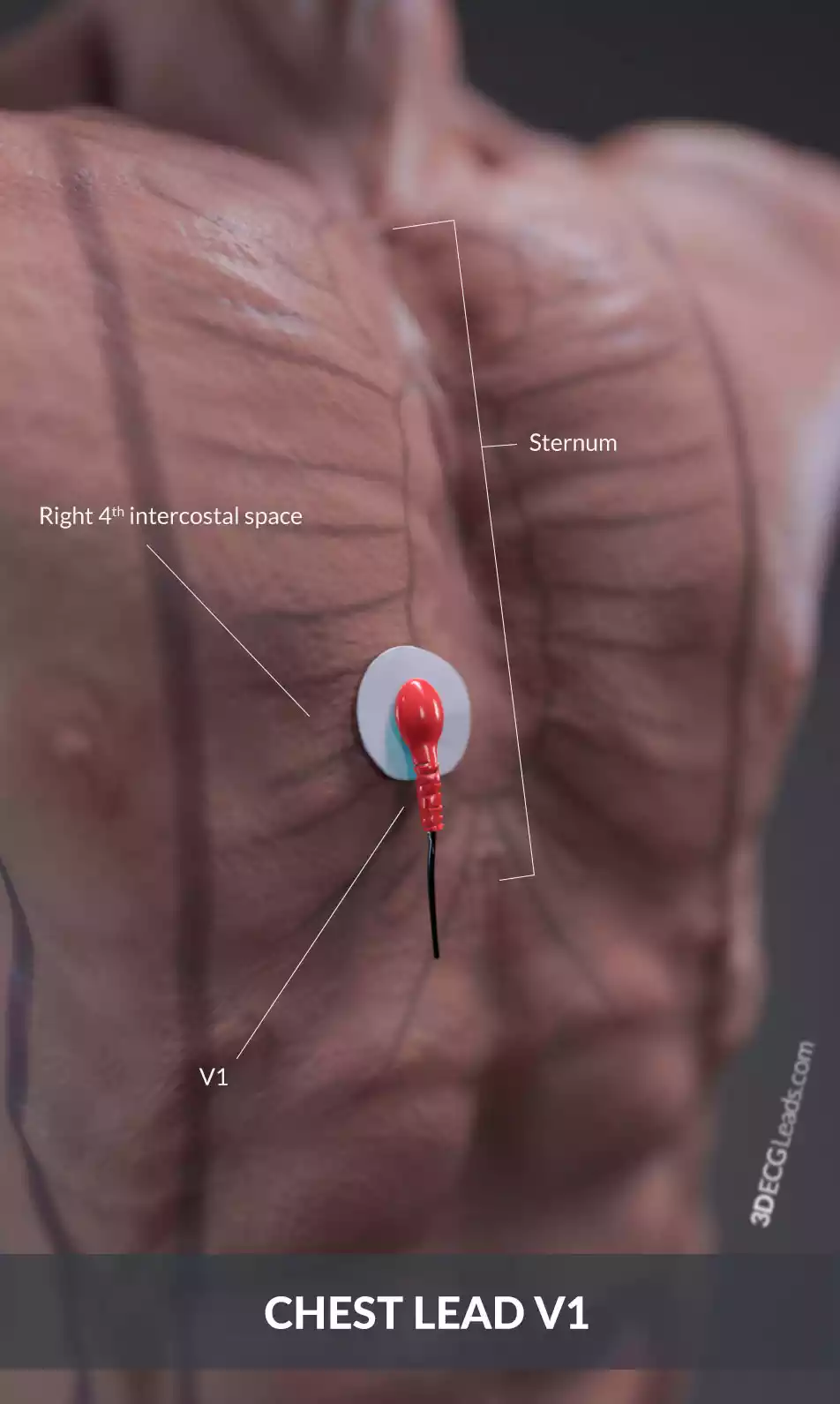
Figure 12 The 1st ECG chest lead to be attached is V1(C1). It should be placed in the 4th Intercostal Space on the Right Border of the Sternum
CHEST LEAD PLACEMENT - V2
The 2nd ECG chest lead that is to be placed is V2(C2). Place it in the 4th Intercostal Space on the Left Border of the Sternum (Eldrige , et al., 2014), Figure 13.
- Step 1
- Palpate the Jugular Notch.
- Step 2
- Slide your fingers down until you feel a ridge (the Sternal Angle of Louis).
- Step 3
- Move your hand to your right and descend into the 2nd Left Intercostal Space.
- Step 4
- Move your hand down one rib to the 3rd Left Intercostal Space.
- Step 5
- Move your hand down one more rib into the 4th Left Intercostal Space.
- Step 6
- Place ECG chest lead V1(C1) electrode in the 4th Left Intercostal Space on the Left Border of the Sternum
CHEST LEAD PLACEMENT - V4
The 3rd ECG chest lead to be placed is V4(C4). It is positioned in the 5th Intercostal Space on the Left Mid-Clavicular Line, the vertical line which passes through the center of the Clavicle (Eldrige , et al., 2014), Figure 14.
- Step 1
- Locate ECG chest lead V2(C2) in the 4th Left Intercostal Space.
- Step 2
- Descend one rib into the 5th Left Intercostal Space.
- Step 3
- Slide your hand to your right along the 5th Left Intercostal Space and stop at the Left Mid-Clavicular Line.
CHEST LEAD PLACEMENT - V3
The 4th ECG chest lead to be placed is V3(C3). It is positioned midway between ECG chest lead V2(C2) and ECG chest lead V4(C4), (Eldrige , et al., 2014), Figure 15.
- Step 1
- Locate ECG chest lead V2(C2) in the 4th Left Intercostal Space.
- Step 2
- Locate ECG chest lead V4(C4) in the 5th Left Intercostal Space on the Mid-Clavicular Line.
- Step 3
- Slide your fingers to your left and position them midway between V2(C2) and V4 (C4).
- Step 4
- Place ECG chest lead V3(C3) midway between V2(C2) and V4(C4).
CHEST LEAD PLACEMENT - V5
The 5th ECG chest lead to be placed is V5 (C5). It is positioned at the same level as the ECG chest lead V4(C4) on the Left Anterior Axillary Line, the vertical line that goes along the Anterior Axillary Fold, (Eldrige , et al., 2014), Figure 16.
- Step 1
- Locate ECG chest lead V4 (C4) in the 5th Left Intercostal Space on the Mid-Clavicular Line.
- Step 2
- Move your hand to your right on a horizontal plane with ECG chest lead V4(C4) and stop on the Left Anterior Axillary Line.
- Step 3
- Place ECG chest lead V5 (C5) here on the Anterior Axillary Line on a horizontal plane with ECG chest lead V4 (C4).
CHEST LEAD PLACEMENT - V6
The 6th ECG chest lead is V6(C6). It is positioned at the same level as ECG chest lead V4(C4) and ECG chest lead V5(C5) on the Left Mid-Axillary Line, the vertical line that goes midway between the Anterior Axillary Fold and the Posterior Axillary Fold, (Eldrige , et al., 2014), Figure 17.
- Step 1
- Locate ECG chest lead V5 (C5) on the Anterior Axillary Line next to ECG chest lead V4(C4).
- Step 2
- Move your hand to your right on a horizontal plane with ECG chest lead V5(C5) and stop on the Left Mid-Axillary Line.
- Step 3
- Place ECG chest lead V6 (C6) here on the Left Mid-Axillary Line on a horizontal plane with ECG chest lead V4(C4) and ECG chest lead V5(C5).
REFERENCES
Crawford, J. (Lecturer in clinical physiology) and Doherty, L. (2012). Positioning the Patient and Locating Electrode Positions, in Practical Aspects of ECG Recording. Keswick: M & K Update Ltd, pp. 18–23.
Wesley, K. (2017). 'The 12-Lead ECG: Leads and Axis’, in Huszar’s ECG and 12-Lead Interpretation. 5th. Riverport Lane: Elsevier, pp. 174–196.

